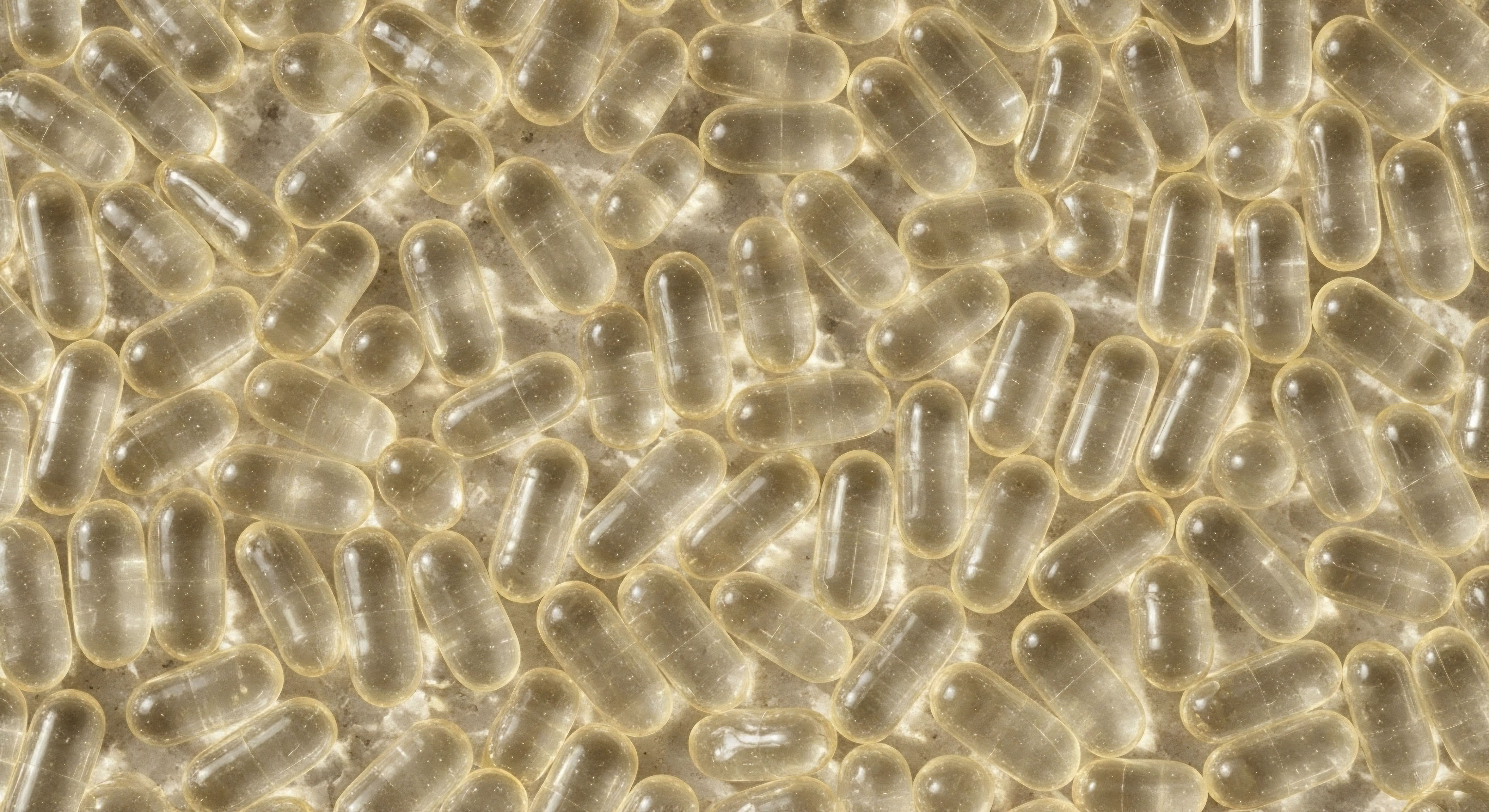

Fundamentals
When you experience shifts in your vitality, perhaps a persistent fatigue that shadows your days, or a subtle but undeniable change in your emotional equilibrium, it is natural to seek explanations. These sensations often prompt a deep inquiry into your body’s internal workings, particularly the intricate dance of your endocrine system.
Many individuals discover that hormonal balance plays a central role in these experiences, leading them to explore personalized wellness protocols. The journey toward reclaiming optimal function frequently involves pharmaceutical interventions, yet a critical, often overlooked aspect of these therapies is their inherent stability.
Consider the delicate nature of the biological messengers within your body. Hormones, peptides, and other biochemical agents operate with precise molecular structures, each designed to fit a specific receptor, much like a key entering a lock. This molecular integrity is paramount for their intended biological action.
When a pharmaceutical compound, whether a synthetic hormone or a therapeutic peptide, is introduced, its efficacy hinges on maintaining this exact structure from the moment of its manufacture until it reaches its target within your system.
The effectiveness of a pharmaceutical relies on its molecular structure remaining intact from production to biological interaction.
Temperature excursions, those unexpected deviations from recommended storage conditions, pose a significant threat to this molecular integrity. Pharmaceuticals are chemical entities, and like all chemical entities, they are subject to the laws of thermodynamics. Elevated temperatures accelerate chemical reactions, including those that lead to degradation.
Conversely, freezing temperatures can cause physical changes, such as precipitation or denaturation, particularly in complex biological molecules like peptides. Understanding these fundamental principles is the first step in appreciating the profound impact of environmental factors on your personalized wellness journey.
The active pharmaceutical ingredient, or API, within any medication is engineered for a specific purpose. Its molecular configuration dictates its pharmacological activity. When this configuration is altered, even subtly, the drug’s ability to bind to its target, elicit a response, or even be safely metabolized can be compromised. This alteration can manifest as a reduction in potency, meaning you receive less of the intended therapeutic effect, or, in some cases, the formation of entirely new compounds, known as degradation products.
Your body’s endocrine system operates on a principle of precise feedback loops and finely tuned concentrations. Introducing a pharmaceutical that has lost some of its potency, or worse, contains unintended byproducts, can disrupt this delicate equilibrium. The symptoms you are seeking to alleviate might persist, or new, unexpected responses could arise. This highlights the importance of understanding how external factors, such as temperature, can directly influence the internal chemistry of your therapeutic agents and, by extension, your own biological systems.
The stability of a pharmaceutical product is not merely a technical detail for manufacturers; it is a direct determinant of patient outcomes. Every individual embarking on a journey to optimize their hormonal health invests time, resources, and hope into their chosen protocols. The assurance that each dose delivers its full, intended therapeutic value is fundamental to achieving desired health objectives and restoring a sense of well-being.


Intermediate
The pursuit of hormonal balance often involves specific clinical protocols, such as Testosterone Replacement Therapy (TRT) for men and women, or various growth hormone peptide therapies. These interventions rely on the consistent delivery of precise dosages.
The efficacy of these treatments, however, is not solely dependent on the initial quality of the medication; it is profoundly influenced by how these compounds are handled and stored throughout their lifecycle. Temperature excursions present a silent, yet significant, challenge to the intended therapeutic outcomes.
Consider the case of Testosterone Cypionate, a common form of testosterone used in replacement therapy. This compound is an oil-soluble ester of testosterone, typically supplied as an intramuscular injection. Regulatory guidelines specify storage conditions, often recommending temperatures between 15°C to 25°C (59°F to 77°F), with permitted excursions up to 30°C (86°F).
While testosterone cypionate is generally considered stable in air and relatively robust compared to more complex biological molecules, prolonged exposure to temperatures outside this range can still compromise its integrity. Elevated temperatures can accelerate chemical degradation pathways, potentially leading to a reduction in the active pharmaceutical ingredient over time. This means a patient expecting a 200mg dose might, after prolonged improper storage, receive a significantly lower effective dose, impacting their symptom management and overall progress.
Improper storage of testosterone cypionate can reduce its effective dose, hindering patient progress.
Progesterone, another vital hormone used in female hormone balance protocols, exhibits varying stability profiles depending on its formulation. Micronized progesterone, often found in soft capsules or compounded topical preparations, is generally stable in air but sensitive to light.
While some formulations may tolerate room temperature storage, others, particularly compounded creams or rapid-dissolving tablets, show a significant decrease in stability over time, even at controlled temperatures. For instance, compounded progesterone preparations have been observed to retain over 95% potency for up to 60 days, but then experience a notable decline, regardless of whether they are stored at 25°C or 4°C.
This highlights that even seemingly minor temperature fluctuations or extended storage beyond recommended periods can lead to a loss of therapeutic concentration, affecting cycle regulation, mood stability, or pregnancy support.
Peptide therapies, such as those involving Sermorelin, Ipamorelin, CJC-1295, or Tesamorelin, represent a more complex stability challenge. Peptides are chains of amino acids, and their biological activity is highly dependent on their precise three-dimensional structure. They are inherently more susceptible to degradation than smaller, simpler steroid hormones. Common degradation pathways for peptides include hydrolysis, oxidation, and aggregation.
- Hydrolysis ∞ Water molecules can cleave peptide bonds, breaking the chain into smaller, inactive fragments. This process is accelerated by both acidic and basic conditions, as well as elevated temperatures.
- Oxidation ∞ Certain amino acid residues within a peptide, such as methionine, tryptophan, and cysteine, are vulnerable to oxidation, which can alter the peptide’s structure and reduce its activity.
- Aggregation ∞ Peptides can self-associate to form larger, insoluble aggregates, particularly under stress conditions like temperature fluctuations, agitation, or extreme pH. These aggregates are typically inactive and can even elicit an unwanted immune response.
Many peptide drugs require storage at low temperatures, often necessitating a “cold chain” during transportation and storage to maintain their integrity. A break in this cold chain, even for a short duration, can initiate irreversible degradation processes. The impact of such degradation is not merely a reduced effect; it can mean the complete loss of therapeutic benefit, as the body’s receptors may no longer recognize the altered peptide.
The implications of compromised pharmaceutical efficacy extend beyond financial considerations. For individuals relying on these therapies to manage chronic conditions or to optimize their health, a reduction in potency translates directly into a lack of symptom improvement, prolonged discomfort, or a failure to achieve desired physiological changes. This can lead to frustration, a sense of hopelessness, and a questioning of the protocol itself, when the underlying issue may be the integrity of the medication.
To mitigate these risks, patients and healthcare providers must prioritize adherence to storage guidelines. This includes proper refrigeration when required, avoiding direct sunlight, and minimizing exposure to extreme temperatures during transport. Understanding the specific stability requirements for each medication is a fundamental aspect of a truly personalized and effective wellness protocol.


Academic
The long-term effects of temperature excursions on pharmaceutical efficacy represent a complex interplay of chemical kinetics, molecular biology, and regulatory science. A deep understanding of these mechanisms is essential for both pharmaceutical development and the practical application of personalized wellness protocols. The degradation of active pharmaceutical ingredients (APIs) is not a simple linear process; it involves specific pathways influenced by environmental factors, ultimately impacting bioavailability, receptor binding, and patient safety.
At the molecular level, temperature directly influences the rate of chemical reactions, as described by the Arrhenius equation. This equation posits that reaction rates increase exponentially with temperature. For pharmaceutical compounds, this means that even small, transient increases in temperature can significantly accelerate degradation processes such as hydrolysis, oxidation, and racemization.
Hydrolysis, the cleavage of a bond by water, is a common degradation pathway for many drugs, particularly those with ester or amide linkages. Oxidation, involving the loss of electrons, often affects compounds with susceptible functional groups, leading to the formation of inactive or even toxic byproducts.
Peptides, being macromolecules, are particularly susceptible to a broader range of degradation mechanisms, including deamidation, aggregation, and disulfide exchange reactions. Deamidation, the removal of an amide group, can alter the charge and conformation of a peptide, reducing its biological activity. Aggregation, the self-association of peptide molecules into insoluble complexes, is a major concern for peptide therapeutics.
These aggregates can not only lead to a loss of active drug but also trigger immunogenic responses in patients, potentially leading to adverse reactions or the neutralization of the therapeutic effect. The precise three-dimensional structure, or conformation, of a peptide is paramount for its interaction with specific receptors. Temperature-induced denaturation, a process where the peptide unfolds from its native conformation, can render it biologically inert.
For steroid hormones like testosterone and progesterone, while generally more chemically stable than peptides, prolonged or severe temperature excursions can still lead to degradation. For instance, testosterone cypionate, an ester, can undergo hydrolysis, releasing free testosterone and cyclopentylpropionic acid.
While free testosterone is the active form, the rate of release and the overall stability of the preparation can be compromised, leading to unpredictable dosing over time. Progesterone, particularly in compounded formulations, has shown susceptibility to degradation over time, even under controlled conditions, suggesting that its stability is formulation-dependent and sensitive to extended storage.

How Do Regulatory Bodies Address Pharmaceutical Stability?
International regulatory bodies, such as the International Council for Harmonisation (ICH), establish rigorous guidelines for pharmaceutical stability testing. These guidelines define specific temperature and humidity conditions for long-term, intermediate, and accelerated stability studies. The purpose of these studies is to provide evidence on how the quality of a drug substance or product changes over time under various environmental influences, thereby determining its shelf life and recommended storage conditions.
ICH guidelines categorize global regions into climatic zones, each with defined temperature and humidity parameters to simulate real-world storage environments. For example, Zone IV, representing hot and humid regions, requires long-term stability testing at 30°C and 65-75% relative humidity.
These stringent requirements ensure that pharmaceutical products maintain their quality, safety, and efficacy throughout their designated shelf life, even when distributed across diverse global supply chains. In regions like China, adherence to these international standards, often supplemented by specific national regulations (e.g. those from the National Medical Products Administration, NMPA), is critical for market access and patient safety. The procedural complexities of demonstrating stability across these varied conditions necessitate robust quality control systems.
| Test Type | Temperature (°C) | Relative Humidity (RH%) | Duration | Relevant Climatic Zones |
|---|---|---|---|---|
| Long-Term | 25 ± 2 or 30 ± 2 | 60 ± 5 or 65 ± 5 | 12 months minimum | I, II, III, IV |
| Intermediate | 30 ± 2 | 65 ± 5 | 6 months minimum | (If long-term is 25°C) |
| Accelerated | 40 ± 2 | 75 ± 5 | 6 months minimum | All zones (for rapid degradation prediction) |

What Are the Clinical Ramifications of Compromised Pharmaceutical Integrity?
The clinical ramifications of pharmaceutical degradation are substantial. A reduction in the active ingredient’s concentration directly translates to a lower effective dose delivered to the patient. For individuals undergoing hormone replacement therapy, this can mean persistent symptoms of hormonal deficiency, such as fatigue, mood disturbances, or reduced libido, despite adherence to their prescribed regimen.
The body’s intricate feedback loops, such as the Hypothalamic-Pituitary-Gonadal (HPG) axis, are highly sensitive to circulating hormone levels. Inconsistent or sub-potent dosing can prevent the HPG axis from recalibrating effectively, hindering the restoration of physiological balance.
Beyond reduced efficacy, the formation of degradation products poses a distinct safety concern. These impurities can be pharmacologically inactive, or worse, they can possess their own biological activity, potentially leading to unexpected side effects or toxicity. Some degradation products may even be genotoxic, meaning they can damage DNA.
Regulatory guidelines mandate strict limits on impurities, and pharmaceutical companies conduct extensive forced degradation studies to identify and characterize these potential byproducts. The presence of such impurities, even in small amounts, necessitates a careful risk-benefit analysis, particularly for long-term therapies.
| Impact Category | Description | Clinical Consequence |
|---|---|---|
| Reduced Potency | Lower concentration of active drug due to breakdown. | Suboptimal therapeutic effect; persistent symptoms; treatment failure. |
| Altered Bioavailability | Changes in drug absorption or distribution in the body. | Unpredictable drug levels; difficulty in dose titration. |
| Formation of Toxic Byproducts | Degradation leads to new, harmful chemical entities. | Adverse drug reactions; organ toxicity; immunogenicity. |
| Physical Instability | Changes in appearance, solubility, or injectability (e.g. aggregation). | Difficulty in administration; potential for local reactions; reduced patient adherence. |

What Are the Procedural Safeguards in Pharmaceutical Supply Chains?
Ensuring pharmaceutical integrity across complex global supply chains, particularly those involving sensitive biologicals like peptides and hormones, requires robust procedural safeguards. This involves adherence to Good Manufacturing Practices (GMP), Good Distribution Practices (GDP), and stringent cold chain management. Manufacturers must conduct comprehensive stability studies under various conditions to establish appropriate storage recommendations and expiry dates.
The transportation phase is particularly vulnerable to temperature excursions. Specialized logistics providers employ temperature-controlled containers and real-time monitoring systems to maintain required conditions. However, the “last mile” of delivery, from a local pharmacy to a patient’s home, can introduce uncontrolled variables. Patients receiving temperature-sensitive medications must be educated on proper storage immediately upon receipt. This includes understanding the critical temperature ranges, the importance of refrigeration, and the potential consequences of deviations.
From a commercial perspective, the economic implications of temperature excursions are significant. Product recalls due to stability issues can result in substantial financial losses, damage to brand reputation, and potential legal liabilities. Pharmaceutical companies invest heavily in formulation science to enhance drug stability, employing strategies such as pH optimization, the addition of stabilizers (e.g.
antioxidants, cryoprotectants), and advanced packaging materials. For peptides, strategies like chemical modification of amino acid residues or cyclization can improve thermal stability and resistance to enzymatic degradation.

How Can Regulatory Compliance Mitigate Risks in Global Pharmaceutical Trade?
Regulatory compliance plays a central role in mitigating the risks associated with temperature excursions, especially in the context of global pharmaceutical trade. Agencies like China’s NMPA, in alignment with ICH guidelines, enforce strict requirements for stability data submission as part of drug registration processes. This includes data from long-term studies reflecting real-time storage conditions in relevant climatic zones, as well as accelerated studies to predict degradation pathways.
The legal framework surrounding pharmaceutical quality ensures accountability. Manufacturers are legally obligated to ensure their products meet specified quality standards throughout their shelf life. Failure to do so can result in regulatory actions, fines, and market withdrawal of products. For patients, this regulatory oversight provides a layer of protection, ensuring that the medications they receive are both safe and effective.
The ongoing surveillance of drug quality through post-market studies and adverse event reporting systems helps identify unforeseen stability issues that may arise in real-world use.

References
- Manning, M.C. Patel, K. & Borchardt, R.T. (1989). Stability of Protein Pharmaceuticals. Pharmaceutical Research, 6(11), 903-918.
- Oliveira Melo, S.R. Homem-de-Mello, M. & Silveira, D. (2016). Advice on Degradation Products in Pharmaceuticals ∞ A Toxicological Evaluation. Journal of Pharmaceutical Sciences, 105(6), 1797-1804.
- International Council for Harmonisation of Technical Requirements for Pharmaceuticals for Human Use (ICH). (2003). Q1A(R2) ∞ Stability Testing of New Drug Substances and Products.
- Nguyen, Q.H. (2014). Risk Assessment for Drug Degradation Products Using Physiologically-Based Pharmacokinetic Models (Doctoral dissertation). University of Iowa.
- Akers, M.J. (2002). Parenteral Quality Control ∞ Sterility, Pyrogen, Particulate, and Package Integrity Testing (3rd ed.). Marcel Dekker.
- Bajaj, S. Singla, D. & Sakhuja, N. (2012). Stability Testing of Pharmaceutical Products ∞ An Overview. Journal of Applied Pharmaceutical Science, 2(3), 129-138.
- Singh, S. & Bakshi, M. (2000). Guidance on Conduct of Stress Studies to Determine Inherent Stability of Drugs. Pharmaceutical Technology, 24(10), 1-14.
- US Food and Drug Administration. (2022). Testosterone Cypionate Injection Prescribing Information.
- European Medicines Agency. (2017). Public Assessment Report Scientific Discussion Progesteron GLF 100 mg and 200 mg Soft Capsules.
- Sajeesh, P.K. & Sreeram, K.J. (2015). Designing Formulation Strategies for Enhanced Stability of Therapeutic Peptides in Aqueous Solutions ∞ A Review. Molecules, 28(6), 2720.

Reflection
Understanding the science behind pharmaceutical stability is not merely an academic exercise; it is a direct pathway to reclaiming agency over your health journey. The insights gained into how temperature influences the very molecules intended to restore your balance offer a new lens through which to view your wellness protocols.
This knowledge empowers you to ask more precise questions, to advocate for optimal storage and handling, and to approach your therapeutic regimen with a deeper appreciation for its intricate biological underpinnings.
Your body is a system of profound intelligence, constantly striving for equilibrium. When you provide it with the right tools, delivered with their full intended potency, you are supporting its innate capacity for restoration. This understanding moves beyond simply taking a medication; it becomes a partnership with your own physiology, a deliberate act of recalibration.
The path to vitality is personal, and every piece of knowledge, especially concerning the integrity of your therapeutic agents, serves as a vital step toward achieving your unique health aspirations.



